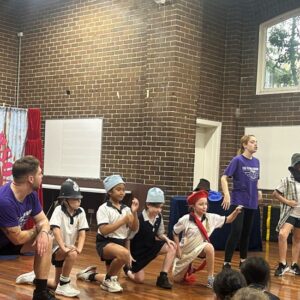
Primary Poetry Week
Celebrating Poetry Week
There was movement at SCEGGS Primary,
For the word has passed around,
That a celebration of poetry was taking place,
It was the talk of the playground!
From Robert Frost and William Blake to Banjo Paterson and Dr. Seuss, poetry filled the Primary School classrooms as teachers and students explored the art form together in the last week of Term 1. Whether through oracy, reading, writing, drama, art or music, the girls were encouraged to embrace the emotion, joy, originality, and playfulness that poetry brings.
In Stage 3, the girls delved into poetry using mentor texts like The Road not Taken by Robert Frost and Tyger, Tyger by William Blake. Each class took part in Poetry in Action workshops, immersing themselves in the rhythm and imagery of these texts. The workshops not only inspired their own writing but also deepened their understanding of intent and techniques, particularly meter, as they embodied the musicality of each poem and created visual representations to enhance their comprehension.
Stage 2 commenced Poetry Week with a performance of Banjo Paterson’s classic poems, including Mulga Bill’s Bicycle, The Man from Iron Bark, and The Geebung Polo Club, alongside choral readings of selected poems. However, their exploration was not confined to the bush ballads of an Australian legend; they also immersed themselves in various poetic forms and literary techniques, further inspiring their own poetry writing.
The younger learners engaged in the rhythm, rhyme, and playfulness of poetry, captivated by the whimsical charm of Dr. Seuss! This immersion in poetry not only deepened their love for reading but also played an important role in cultivating a richer appreciation and understanding of language among our K-2 learners.
Poetry Week was a great way to end the term, showing us the magic of poetry and reminding us that everyone can be a poet in their own special way.
We hope you enjoy some of the student’s work below:
Exploring the question-What is poetry?
Poetry is a broad and unique genre of writing, composed to express feelings and thoughts. It uses techniques such as rhythm, rhyme, and structure to convey a sense of musicality and tone. To give emotion to the piece, it includes vivid imagery so that the reader can clearly visualise and interpret what the poem is saying. The five senses and figurative language are used by poets to do so. Poetry can be as short and simple as a couple of words, or as long and complex as a Shakespearian sonnet. In review, poetry is a mix of words, visuals and song.
Annabel Ling (Year 5)
Autumn
Leaves twirl and pirouette in the chilly wind,
Dancing to a melody no-one can hear.
The foliage crinkles in song like pages turning,
As the last of the emerald-green leaves disappear.
Harriet Chandler (Year 6)
The Old Acacia Tree
A wise old acacia tree lives at the end of the Earth,
And the wattles which she grows should not be concerned.
For the tree has lived, regardless of its worth,
For thousands of years in the same damp dirt.
And oh, the remarkable things she has learned.
Alexandra Millin (Year 6)
Playing with Sound Using Alliteration
Joyful Georgina
Joyful Georgina went on a jam-packed journey to Japan with her giraffe called Gerald.
Then Gerald the giraffe jumped out of the jittery jeep and started jiggling the Jupiter jig.
Joyful Georgina joked that Gerald was a jovial jogger from Jupiter.
Jealous Jade was less than joyful or jovial, she was joyless.
Gerald and joyful Georgina jumped back into their jeep and continued their journey to Japan.
Georgina Sharp (Year 4)
Autumn is Here
Bright leaves swiftly sway
Icy air whispers a song
Vivid leaves falling.
Tove Klettenberg (Year 3)
Kristy Williams
Acting Co-ordinator of Curriculum (English)




